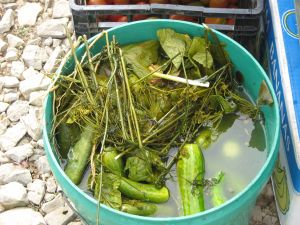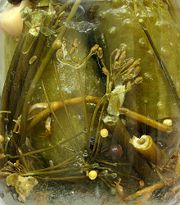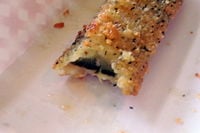Difference between revisions of "Pickled cucumber" - New World Encyclopedia
(article fixed) |
(ready tag added) |
||
| Line 1: | Line 1: | ||
| + | {{ready}} | ||
| + | |||
[[Image:Pickle.jpg|thumb|180px|A deli pickle.]] | [[Image:Pickle.jpg|thumb|180px|A deli pickle.]] | ||
A '''pickled cucumber''', most often simply called a '''pickle''' in the [[United States]] and [[Canada]], is a [[cucumber]] that has been [[Pickling|pickled]] in a [[brine]], [[vinegar]], or other solution. | A '''pickled cucumber''', most often simply called a '''pickle''' in the [[United States]] and [[Canada]], is a [[cucumber]] that has been [[Pickling|pickled]] in a [[brine]], [[vinegar]], or other solution. | ||
==Origin== | ==Origin== | ||
| − | Cucumbers were probably first pickled 4400 years ago in [[Mesopotamia]].<ref name="timeline"> | + | Cucumbers were probably first pickled 4400 years ago in [[Mesopotamia]].<ref name="timeline">[http://www.nyfoodmuseum.org/_ptime.htm Pickle History Timeline] - ''New York Food Museum''. Retrieved November 2, 2007.</ref> In India, pickles were well known by the [[Vedic period]].<ref name="bestmaid">[http://www.bestmaidproducts.com/BestMaidHTML/history/picklinghistory.asp Pickling History] - ''Best-Maid''. Retrieved November 2, 2007.</ref> Cucumber pickling might have spread through the [[Judaism|Jewish]] [[diaspora]]. |
| − | The pickling process was also known to the [[Ancient Greece|Ancient Greeks]]. [[Aristotle]] is reported to have praised pickled cucumbers for their healing effects.<ref name="timeline" /><ref name="bestmaid" /> [[Julius Caesar]]'s soldiers ate pickled cucumbers as health aids;<ref name="bestmaid" /> many other brine-soaked foods were part of daily life in [[Ancient Rome]].<ref>Kurlansky | + | The pickling process was also known to the [[Ancient Greece|Ancient Greeks]]. [[Aristotle]] is reported to have praised pickled cucumbers for their healing effects.<ref name="timeline" /><ref name="bestmaid" /> [[Julius Caesar]]'s soldiers ate pickled cucumbers as health aids;<ref name="bestmaid" /> many other brine-soaked foods were part of daily life in [[Ancient Rome]].<ref>Mark Kurlansky. ''Salt: A History of the World''. New York : Walker and Co., 2002. ISBN 0802713734 ISBN 9780802713735</ref> Cucumber pickling remained widespread across the [[Levant]] and [[Maghreb]] regions, where it is still very popular today. A pickle slice is commonly referred to as a 'chip'. |
Pickled cucumbers became popular in the United States due to the influence of the cuisine of Eastern European immigrants. | Pickled cucumbers became popular in the United States due to the influence of the cuisine of Eastern European immigrants. | ||
| Line 16: | Line 18: | ||
==Types== | ==Types== | ||
===Gherkin=== | ===Gherkin=== | ||
| − | A [[gherkin]] is not only a pickle of a certain size but also a particular species of cucumber: the [[West Indian]] or Burr cucumber ''(Cucumis anguria)'', which produces a somewhat smaller fruit than the [[garden cucumber]] ''([[Cucumis sativus]])''.<ref> | + | A [[gherkin]] is not only a pickle of a certain size but also a particular species of cucumber: the [[West Indian]] or Burr cucumber ''(Cucumis anguria)'', which produces a somewhat smaller fruit than the [[garden cucumber]] ''([[Cucumis sativus]])''.<ref>[http://plantanswers.tamu.edu/vegetables/cucumber.html Cucumber Q&A] - plantanswers.tamu.edu. Retrieved November 2, 2007.</ref> Standard pickles are made from the West Indian cucumber, but the term ''gherkin'' has become loosely used as any small cucumber pickled in a sweet [[vinegar]] brine, regardless of the variety of cucumber used. |
===Kosher dill=== | ===Kosher dill=== | ||
| − | A "kosher" '''dill pickle''' is usually not [[kosher]] in the sense that it has been prepared under rabbinical supervision, which would ensure that no utensil in contact with the pickles had been in contact with food that was not kosher. Rather, it is a pickle made in the traditional manner of Jewish [[New York City]] pickle makers, with generous addition of [[garlic]] to the brine.<ref>[http://www.nyfoodmuseum.org/_pkwhat.htm | + | A "kosher" '''dill pickle''' is usually not [[kosher]] in the sense that it has been prepared under rabbinical supervision, which would ensure that no utensil in contact with the pickles had been in contact with food that was not kosher. Rather, it is a pickle made in the traditional manner of Jewish [[New York City]] pickle makers, with generous addition of [[garlic]] to the brine.<ref>[http://www.nyfoodmuseum.org/_pkwhat.htm What is a Pickle?] - nyfoodmuseum.org. Retrieved November 2, 2007.</ref><ref>[http://www.jewfaq.org/kashrut.htm Kashrut: Jewish Dietary Laws "Judaism 101"] - jewfaq.org. Retrieved November 2, 2007.</ref> |
===Polish=== | ===Polish=== | ||
| Line 28: | Line 30: | ||
===Lime=== | ===Lime=== | ||
| − | Lime pickles are soaked in [[Lime (mineral)|lime]] rather than in a salt brine.<ref>[http://www.recipesource.com/fgv/pickles/01/rec0113.html Recipe Source | + | Lime pickles are soaked in [[Lime (mineral)|lime]] rather than in a salt brine.<ref>[http://www.recipesource.com/fgv/pickles/01/rec0113.html Lime Pickles] - Recipe Source. Retrieved November 2, 2007.</ref> Vinegar and sugar are often added after the 24-hour soak in lime, along with [[pickling spices]], although this is done more to enhance flavor than as a preservative. |
===Bread and butter=== | ===Bread and butter=== | ||
| Line 34: | Line 36: | ||
==Nutrition== | ==Nutrition== | ||
| − | Much like [[sauerkraut]] (also technically a [[pickle]]), pickled cucumbers are rich in [[vitamin C]]. Cucumbers have a mild anti-inflammatory effect, although how much of this effect is retained after the pickling process is up for debate. For more information, see [http://www.nutritiondata.com/facts-C00001-01c20mU.html | + | Much like [[sauerkraut]] (also technically a [[pickle]]), pickled cucumbers are rich in [[vitamin C]]. Cucumbers have a mild anti-inflammatory effect, although how much of this effect is retained after the pickling process is up for debate. For more information, see NutritionData: Pickles<ref>[http://www.nutritiondata.com/facts-C00001-01c20mU.html Pickles] - ''NutritionData''. Retrieved November 2, 2007.</ref> |
==Serving== | ==Serving== | ||
| Line 40: | Line 42: | ||
Pickles are often served as a "side" to various lunches in the form of a "pickle spear," which is a pickled cucumber cut length-wise into quarters or sixths. The pickle may be used as a condiment on a hamburger or other sandwich (usually in slice form), or to a [[sausage]] or [[hot dog]] in chopped form as [[pickle relish]]. | Pickles are often served as a "side" to various lunches in the form of a "pickle spear," which is a pickled cucumber cut length-wise into quarters or sixths. The pickle may be used as a condiment on a hamburger or other sandwich (usually in slice form), or to a [[sausage]] or [[hot dog]] in chopped form as [[pickle relish]]. | ||
| − | Soured cucumbers are commonly used in a variety of dishes—for example, pickle-stuffed meatloaf,<ref>[http://www.ilovepickles.org/recipes/meatloaf.html Pickled Stuffed Meatloaf] | + | Soured cucumbers are commonly used in a variety of dishes—for example, pickle-stuffed meatloaf,<ref>[http://www.ilovepickles.org/recipes/meatloaf.html Pickled Stuffed Meatloaf] - ilovepickles.org. Retrieved November 2, 2007.</ref> potato salad or [[chicken salad]]—or consumed alone as an appetizer. |
Pickles have also been introduced in [[Frying|fried]] form, either [[Deep-frying|deep-fried]] plain, or with a [[breading]] surrounding the spear. | Pickles have also been introduced in [[Frying|fried]] form, either [[Deep-frying|deep-fried]] plain, or with a [[breading]] surrounding the spear. | ||
| − | == | + | ==Notes== |
<references/> | <references/> | ||
| − | + | ==References== | |
*{{Citation | *{{Citation | ||
| last = Battcock | | last = Battcock | ||
| Line 53: | Line 55: | ||
| last2 = Azam-Ali | | last2 = Azam-Ali | ||
| first2 = Sue | | first2 = Sue | ||
| − | | year = | + | | year = |
| title = Fermented Fruits and Vegetables: A Global Perspective | | title = Fermented Fruits and Vegetables: A Global Perspective | ||
| place = Rome | | place = Rome | ||
| − | | publisher = Food and Agriculture Organization of the United Nations | + | | publisher = Food and Agriculture Organization of the United Nations, 1998 |
| − | | isbn = | + | | isbn = 9251042268 |
| − | | oclc = | + | | oclc = 4 |
}}. | }}. | ||
| − | [[Category: | + | [[Category:Life sciences]] |
| − | |||
| − | |||
| − | |||
| − | |||
{{credits|Pickled_cucumber|168563455}} | {{credits|Pickled_cucumber|168563455}} | ||
Revision as of 15:11, 2 November 2007
A pickled cucumber, most often simply called a pickle in the United States and Canada, is a cucumber that has been pickled in a brine, vinegar, or other solution.
Origin
Cucumbers were probably first pickled 4400 years ago in Mesopotamia.[1] In India, pickles were well known by the Vedic period.[2] Cucumber pickling might have spread through the Jewish diaspora.
The pickling process was also known to the Ancient Greeks. Aristotle is reported to have praised pickled cucumbers for their healing effects.[1][2] Julius Caesar's soldiers ate pickled cucumbers as health aids;[2] many other brine-soaked foods were part of daily life in Ancient Rome.[3] Cucumber pickling remained widespread across the Levant and Maghreb regions, where it is still very popular today. A pickle slice is commonly referred to as a 'chip'.
Pickled cucumbers became popular in the United States due to the influence of the cuisine of Eastern European immigrants.
Process
Cucumber pickling is almost universally done through a brine fermentation process. Ripe cucumbers are selected, washed and salted thoroughly, and then added to a brine solution for a number of weeks. Vinegar, sugar and spices can be added to the process, depending on the technique used.
Types
Gherkin
A gherkin is not only a pickle of a certain size but also a particular species of cucumber: the West Indian or Burr cucumber (Cucumis anguria), which produces a somewhat smaller fruit than the garden cucumber (Cucumis sativus).[4] Standard pickles are made from the West Indian cucumber, but the term gherkin has become loosely used as any small cucumber pickled in a sweet vinegar brine, regardless of the variety of cucumber used.
Kosher dill
A "kosher" dill pickle is usually not kosher in the sense that it has been prepared under rabbinical supervision, which would ensure that no utensil in contact with the pickles had been in contact with food that was not kosher. Rather, it is a pickle made in the traditional manner of Jewish New York City pickle makers, with generous addition of garlic to the brine.[5][6]
Polish
Polish style pickled cucumbers (Polish: ogórek kiszony) are a type of pickled cucumber developed in the northern parts of Europe and have been exported worldwide and are found in the cuisines of many countries. As opposed to some other varieties of pickled cucumbers, they are prepared using the traditional process of natural fermentation in a salty brine which makes them grow sour. There is no vinegar used in the brine of a Polish-style pickled cucumber (Ogórek kiszony).
Typically, small cucumbers are placed in a ceramic vessel or a wooden barrel, together with a variety of spices. Among those traditionally used in many recipes are garlic, horseradish, fennel, cumin, oak and cherry leaves, and—most importantly—salt. The cucumbers are then placed under clear water and kept under a non-airtight cover for several weeks, depending on taste and external temperature. The more salt is added the more sour the cucumbers become. Since they are produced without vinegar, a scum forms on the top, but this does not indicate they have spoiled, and the scum is just removed. They do not, however, keep as long as cucumbers pickled with vinegar.
Lime
Lime pickles are soaked in lime rather than in a salt brine.[7] Vinegar and sugar are often added after the 24-hour soak in lime, along with pickling spices, although this is done more to enhance flavor than as a preservative.
Bread and butter
Bread-and-butter pickles are sweeter in flavor than dill pickles, having a high concentration of sugar added to the brine. Rather than being served alongside a sandwich, they are more often used in fully-flavored sandwiches, such as hamburgers, or used in potato salad.
Nutrition
Much like sauerkraut (also technically a pickle), pickled cucumbers are rich in vitamin C. Cucumbers have a mild anti-inflammatory effect, although how much of this effect is retained after the pickling process is up for debate. For more information, see NutritionData: Pickles[8]
Serving
Pickles are often served as a "side" to various lunches in the form of a "pickle spear," which is a pickled cucumber cut length-wise into quarters or sixths. The pickle may be used as a condiment on a hamburger or other sandwich (usually in slice form), or to a sausage or hot dog in chopped form as pickle relish.
Soured cucumbers are commonly used in a variety of dishes—for example, pickle-stuffed meatloaf,[9] potato salad or chicken salad—or consumed alone as an appetizer.
Pickles have also been introduced in fried form, either deep-fried plain, or with a breading surrounding the spear.
Notes
- ↑ 1.0 1.1 Pickle History Timeline - New York Food Museum. Retrieved November 2, 2007.
- ↑ 2.0 2.1 2.2 Pickling History - Best-Maid. Retrieved November 2, 2007.
- ↑ Mark Kurlansky. Salt: A History of the World. New York : Walker and Co., 2002. ISBN 0802713734 ISBN 9780802713735
- ↑ Cucumber Q&A - plantanswers.tamu.edu. Retrieved November 2, 2007.
- ↑ What is a Pickle? - nyfoodmuseum.org. Retrieved November 2, 2007.
- ↑ Kashrut: Jewish Dietary Laws "Judaism 101" - jewfaq.org. Retrieved November 2, 2007.
- ↑ Lime Pickles - Recipe Source. Retrieved November 2, 2007.
- ↑ Pickles - NutritionData. Retrieved November 2, 2007.
- ↑ Pickled Stuffed Meatloaf - ilovepickles.org. Retrieved November 2, 2007.
ReferencesISBN links support NWE through referral fees
- Battcock, Mike & Sue Azam-Ali, Fermented Fruits and Vegetables: A Global Perspective, Rome: Food and Agriculture Organization of the United Nations, 1998, ISBN 9251042268, OCLC {{{oclc}}} .
Credits
New World Encyclopedia writers and editors rewrote and completed the Wikipedia article in accordance with New World Encyclopedia standards. This article abides by terms of the Creative Commons CC-by-sa 3.0 License (CC-by-sa), which may be used and disseminated with proper attribution. Credit is due under the terms of this license that can reference both the New World Encyclopedia contributors and the selfless volunteer contributors of the Wikimedia Foundation. To cite this article click here for a list of acceptable citing formats.The history of earlier contributions by wikipedians is accessible to researchers here:
The history of this article since it was imported to New World Encyclopedia:
Note: Some restrictions may apply to use of individual images which are separately licensed.



